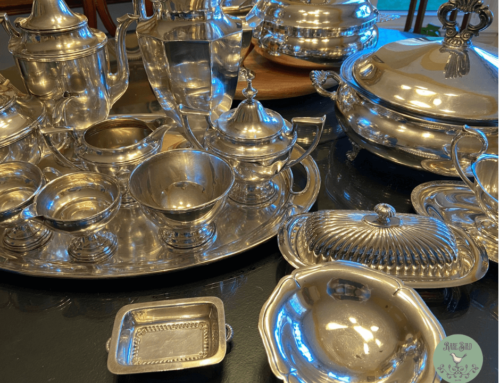Antique Silver: The Basics
Love antique silver and want to start a collection? Basically, there are a few things you should know first – especially since collecting silver can be an expensive undertaking.
Firstly, decide how serious of a collector you intend to be. If you do not want to invest much but want the sparkle and shine a piece of silver offers to your decor, then you may want to look at silver-plate for much of your collection. You see there are two types of silver – silverplate and sterling silver.

Silverplate
Silverplate means a piece is crafted from a base metal and coated with a thin layer of silver. The result is a piece which looks like sterling silver but is much cheaper. Because the piece is plated, it will be much lighter in weight than sterling. Since there is so little real silver in silverplate, it is worth very little. It is not worth melting down, so the real value is usually sentimental or just admiration of form.
Sterling Silver
Sterling silver is either pure silver or it is .925 silver and .075 copper added. A sterling piece made in the USA after 1850, will always be marked in one of three ways:
- Sterling
- .925
- .925/1000
For sterling silver from Europe, pieces will be marked with:
- England: Lion with one paw raised (a Lion Passant)
- Scotland: Thistle
- Ireland: Crowned Harp
For other countries, refer to the Guide to World Marks.
But, if you have run across a piece with no mark and it appears to have the weight of real silver, you may want to have it looked at by a professional who can acid test the piece. Just because the piece does not have a sterling mark does not mean it is not silver. However, if the piece is not marked, it more than likely is silverplate. You know the adage “if it is too good to be true . . ..”
Silver-Plate Marks
There are some common marks for silver-plate. Just remember, as we just mentioned, silver-plate pieces are not always marked.
- Silverplate
- EPNS (Electro-Plated Nickel Silver)
- EPBM (Electro-Plated Britannia Metal)
- EP (Electro-Plated)
- BP (Britannia Plate)

Marks & Hallmarks
In addition to the sterling or silver-plate mark, a piece will have the maker’s mark or hallmark stamped on it. The maker usually places a hallmark on the back or the bottom of the piece. These marks are individual designs created by the manufacturer to identify their work. These marks often changed over the passage of time.
You can research marks and hallmarks on the Online Encyclopedia of Silver Marks, Hallmarks & Makers Marks. We’ve created a Silver Hallmark Chart you can download to use as an easy reference tool when shopping.
Patterns
Not sure what the pattern is? A Google search can yield surprising results. If you know the maker, type in their name, and describe the pattern. You can also conduct an image search on Google. If you are not familiar with searching by images, you can refer to Google Search Help for instructions.
Determining the Pattern
You can also search for patterns on the internet via various sources. For antique flatware, check out Antique Cupboard’s useful Directory of Patterns. Also, Silver Pattern has directories for both silverplate and sterling silver. If you collect silver spoons, you will find Spoon Planet to be a great resource for identifying patterns. Replacements.com offers an Identification Tool to assist in pattern identification.
Value
Replacements is also a reliable source to determine the retail value of your pieces. However, for a true value, you should have them appraised by a professional.
Remember, silver is a precious metal and the melt value of silver on any given day will affect its value even if a piece is an antique. Unfortunately, many antique pieces are being melted down and lost. The antique value may be more than the melt value, but they go hand in hand.
Tips
In conclusion, remember when collecting, the most valuable pieces have no damage and no evidence of repairs. The patina of the surface should have no blemishes and should glow. Any pieces that have an overly white appearance, have been over-cleaned with harsh chemicals. Bottom line: condition and rarity are always going to determine a piece’s value.
In our opinion, silver should be used and not stored away only for special occasions. Using your silver can actually help reduce tarnish. You will get more joy out of your collection if you use it. For tips on care and cleaning – check out: Silver: Care & Cleaning.

